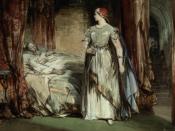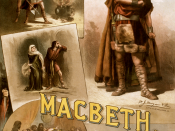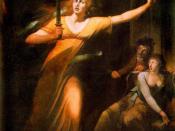The story of "Macbeth" can be broken down into three separate identities: individual identity, dual identity, and social identity. Individual identity is Macbeth independently thinking he knows himself. Dual identity is Macbeth and, his love interest, Lady Macbeth being united and acting as one during the play. Social identity is social groups--the three witches and Macbeth--being joined as one with each other and then divided at the end of the play.
The first identity in Macbeth is Macbeth's individual identity. In the beginning of the play, when the witches meet Macbeth and prophesize he will become Thane of Cawdor and King, he believes he knows himself. After the witches' prophecy, Macbeth becomes very pompous and arrogant. Later, when he arranges Banquo's murder and Banquo's son Fleance escapes, Macbeth becomes unsure of his own future because the witches also prophesized: "Thou shalt get kings, though thou be none" (1.3.65). This means that Banquo will be the father to a line of kings.
Macbeth orders Banquo and his son Fleance to be killed, but Fleance escapes. When Macbeth sees the witches again they warn him to beware of Macduff and that no man born of woman can defeat him. They also show him a vision of Banquo's ghost with eight kings, which makes Macbeth nervous again: "Now I see 'tis true, for the blood-bolter'd Banquo smiles upon me, and points at them for his" (4.1.121-123). When Macbeth orders Macduff's family to be murdered, Macduff joins the English army and kills Macbeth ending Macbeth's life and his identity.
The second identity in Macbeth is the dual identity between Macbeth and Lady Macbeth. They are one with each other in the beginning of the play. Lady Macbeth is the brains and the will while Macbeth is greedy and arrogant. They draw from each...


